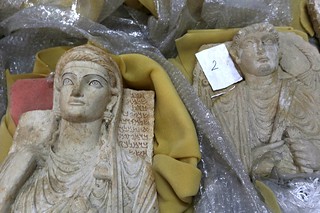
PREV ARTICLE
NEXT ARTICLE
FULL ISSUE
PREV FULL ISSUE
THE CASE FOR BUYING ANTIQUITIES TO SAVE THEM
This August 20, 2015 Wall Street Journal opinion piece by Gary Vikan, former director of the Walters Art Museum (1994-2013).
-Editor
The prevailing view among archaeologists, reflected in bills in Congress, is to exclude from the U.S. all antiquities thought to originate in those countries. This is a mistake. After decades of museum experience with cultural property of uncertain provenance, I believe that we should accept looted antiquities from these troubled areas, even when such action might be considered “encouraging looting.” The expenses that museums might incur—including the costs of returning the pieces to the countries of their origin—are worth paying to keep them out of reach of ISIS sledgehammers. No one, anywhere, should buy art from ISIS. Should U.S. museums buy antiquities from Syria and Iraq, some of the money will likely go to refugees fleeing the region, and some will undoubtedly pass into the hands of the small-time looters and smugglers who have long supplied the bazaars of the two countries. But there is no verifiable evidence, despite a media frenzy, that ISIS obtains significant funding by selling antiquities or taxing art looters. In times of extraordinary risk, we should be open to dealing with bad guys to create a safe harbor for works of art. This is an act of rescue and stewardship—and should be done with the explicit understanding that eventually, when the time is right, the objects will be repatriated to the country of their origin. There are examples of art rescues that might serve as a model. After Turkey invaded northern Cyprus in 1974, the Christian population was forced out and its churches were ransacked. Thousands of Byzantine artworks were plundered, including frescoes from the interior of a tiny chapel near the village of Lysi that showed Christ in the dome and the Virgin Mary in the apse. In the early 1980s a Munich-based Turk named Aydin Dikmen offered these frescoes, cut up into three dozen pieces, on the black market through a London dealer. He identified himself as an archaeologist. Enter Houston oil heiress and arts patron Dominique de Menil. After secret consultations with church and government officials in Nicosia, she bought the frescoes from Mr. Dikmen and then paid to have them restored and reassembled, at a cost of more than $1 million. The Menil Foundation in Houston (for which I worked in the late 1970s) retained the frescoes for almost 25 years, exhibiting them in a modernist chapel beginning in 1997. I was fortunate to have played a role in that rescue. In 2012, by mutual agreement between the Menil Foundation and the government of Cyprus, the Lysi frescoes were returned to the island. They are now displayed in the Byzantine Art Museum in Nicosia. Imagine what would have happened if those frescoes had been intercepted at the U.S. border and sent back to northern Cyprus. Or what would be lost to the world if the frescoes, cut into pieces, had been sold to dozens of private collectors around the globe. If antique statuary like that already destroyed by ISIS is spirited out of Mosul before the next wave of destruction—and then offered on the international black market—museums should not be afraid to act. They should work in consultation with government and museum officials in Baghdad, and with the U.S. State Department. They should exercise the highest standards of due diligence and never do anything to assist ISIS or its affiliates. But I believe a rescue mission would in the future come to be celebrated the way the rescue of the frescoes in northern Cyprus are today.
The world is a confusing damned-if-you-do-damned-if-you-don't place. Do-gooding legislation created with the best of intentions often
has devastating unintended consequences. I don’t have any better answers, but Vikan makes some excellent points. -Editor
To read the complete article, see:

Wayne Homren, Editor The Numismatic Bibliomania Society is a non-profit organization promoting numismatic literature. See our web site at coinbooks.org. To submit items for publication in The E-Sylum, write to the Editor at this address: whomren@gmail.com To subscribe go to: https://my.binhost.com/lists/listinfo/esylum All Rights Reserved. NBS Home Page Contact the NBS webmaster 
|
